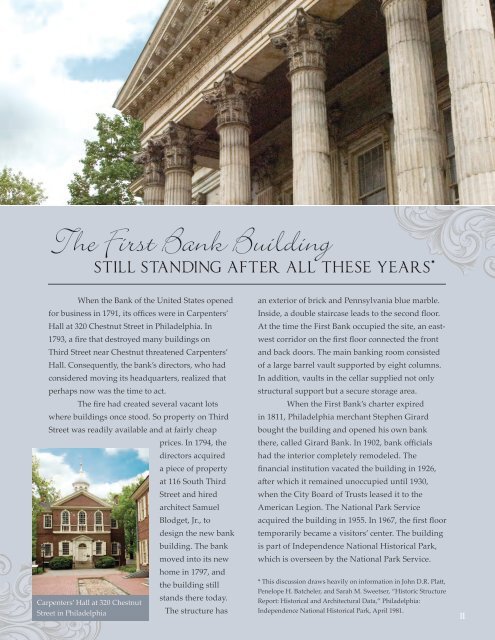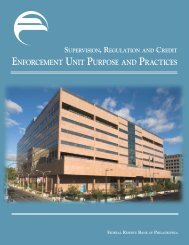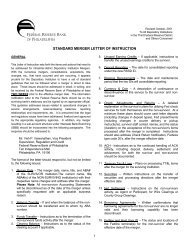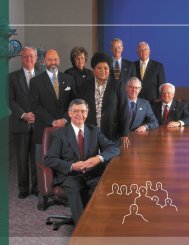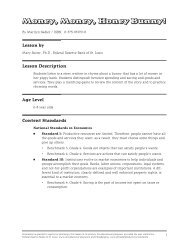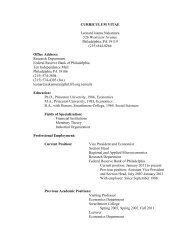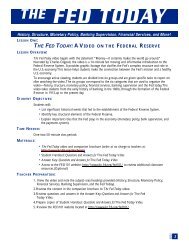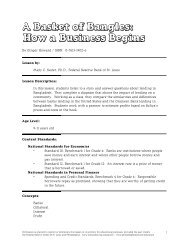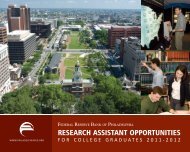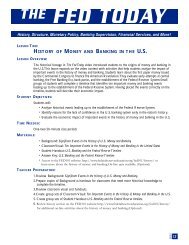The First Bank of the United States - Federal Reserve Bank of ...
The First Bank of the United States - Federal Reserve Bank of ...
The First Bank of the United States - Federal Reserve Bank of ...
You also want an ePaper? Increase the reach of your titles
YUMPU automatically turns print PDFs into web optimized ePapers that Google loves.
<strong>The</strong> <strong>First</strong> <strong>Bank</strong> Building<br />
STILL STANDING AFTER ALL THESE YEARS *<br />
When <strong>the</strong> <strong>Bank</strong> <strong>of</strong> <strong>the</strong> <strong>United</strong> <strong>States</strong> opened<br />
for business in 1791, its <strong>of</strong>fices were in Carpenters’<br />
Hall at 320 Chestnut Street in Philadelphia. In<br />
1793, a fire that destroyed many buildings on<br />
Third Street near Chestnut threatened Carpenters’<br />
Hall. Consequently, <strong>the</strong> bank’s directors, who had<br />
considered moving its headquarters, realized that<br />
perhaps now was <strong>the</strong> time to act.<br />
<strong>The</strong> fire had created several vacant lots<br />
where buildings once stood. So property on Third<br />
Street was readily available and at fairly cheap<br />
prices. In 1794, <strong>the</strong><br />
directors acquired<br />
a piece <strong>of</strong> property<br />
at 116 South Third<br />
Street and hired<br />
architect Samuel<br />
Blodget, Jr., to<br />
design <strong>the</strong> new bank<br />
building. <strong>The</strong> bank<br />
moved into its new<br />
home in 1797, and<br />
<strong>the</strong> building still<br />
stands <strong>the</strong>re today.<br />
Carpenters’ Hall at 320 Chestnut<br />
Street in Philadelphia<br />
<strong>The</strong> structure has<br />
an exterior <strong>of</strong> brick and Pennsylvania blue marble.<br />
Inside, a double staircase leads to <strong>the</strong> second floor.<br />
At <strong>the</strong> time <strong>the</strong> <strong>First</strong> <strong>Bank</strong> occupied <strong>the</strong> site, an eastwest<br />
corridor on <strong>the</strong> first floor connected <strong>the</strong> front<br />
and back doors. <strong>The</strong> main banking room consisted<br />
<strong>of</strong> a large barrel vault supported by eight columns.<br />
In addition, vaults in <strong>the</strong> cellar supplied not only<br />
structural support but a secure storage area.<br />
When <strong>the</strong> <strong>First</strong> <strong>Bank</strong>’s charter expired<br />
in 1811, Philadelphia merchant Stephen Girard<br />
bought <strong>the</strong> building and opened his own bank<br />
<strong>the</strong>re, called Girard <strong>Bank</strong>. In 1902, bank <strong>of</strong>ficials<br />
had <strong>the</strong> interior completely remodeled. <strong>The</strong><br />
financial institution vacated <strong>the</strong> building in 1926,<br />
after which it remained unoccupied until 1930,<br />
when <strong>the</strong> City Board <strong>of</strong> Trusts leased it to <strong>the</strong><br />
American Legion. <strong>The</strong> National Park Service<br />
acquired <strong>the</strong> building in 1955. In 1967, <strong>the</strong> first floor<br />
temporarily became a visitors’ center. <strong>The</strong> building<br />
is part <strong>of</strong> Independence National Historical Park,<br />
which is overseen by <strong>the</strong> National Park Service.<br />
* This discussion draws heavily on information in John D.R. Platt,<br />
Penelope H. Batcheler, and Sarah M. Sweetser, “Historic Structure<br />
Report: Historical and Architectural Data,” Philadelphia:<br />
Independence National Historical Park, April 1981.<br />
<strong>The</strong> <strong>First</strong> <strong>Bank</strong> <strong>of</strong> <strong>the</strong> <strong>United</strong> <strong>States</strong><br />
11


